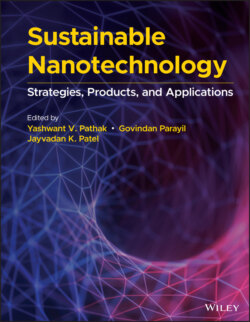Читать книгу Sustainable Nanotechnology - Группа авторов - Страница 12
Оглавление
Foreword
There have been enormous developments in the area of nanotechnology with its application to deliver antimicrobial properties in hand washes, bandages, and socks, and zinc or titanium nanoparticles are the active UV‐protective elements in modern sunscreens. With several innovations a significant interest has developed among governments, industries, and academicians.
Sustainability is now one of the greatest challenges in nanotechnology research. In addition to natural resources, there is a need for social and economic resources. The principle of sustainability has three major pillars: economy, society, and the environment, being translated to profit, people, and planet.
Nanotechnology provides a promise of positively contributing to global sustainability challenges, by providing interesting solutions such as water purification, energy efficiency, cheaper versions for solar energy, and solar panel development. In addition, nanotechnology plays an important role in health care through nanomedicine, nanorobots, nano health care challenges, nano‐pharmacogenomics solutions to chronic diseases, nanoscaffolds, noninvasive surgeries, and so on.
Some challenges posed by nanotechnology are developing sustainable nanotechnology, to deal with potential ecological and health effects of nanotechnology on human health and to design nanotechnology‐based products with minimal environment adverse impact.
This book by Dr(s) Yashwant Pathak, Govindan Parayil, and Jayvadan Patel addresses many of these issues and provides nanotechnology‐based research priorities for global sustainability to improving sustainability and methods for development of various biobased products using sustainable nano biocomposites. Some chapters have also glimpses of novel approaches to design eco‐friendly material based on natural nanomaterials.
I congratulate the editors to bring out this compilation addressing sustainable nanotechnology their strategies, products, and applications.
I am sure that the readers will find this book very useful for improving their understanding about sustainable nanotechnology and to plan further research in the field of nanotechnology.
With best wishes to the editors and all the chapter authors.
Prof. (Dr.) Ramesh K. Goyal
Vice Chancellor
Delhi Pharmaceutical Sciences and Research University, India
